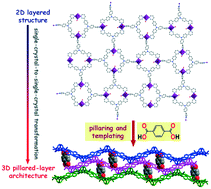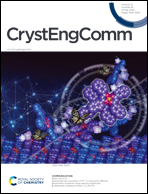Pillar–template strategy switching the redox activity and magnetic properties of trisphenylamine-based coordination polymers†
Abstract
It is an efficient approach to exploit a pillaring and templating strategy for creating varieties of functionalized coordination polymers (CPs). Four novel CPs incorporating single metal nodes and a redox-active tris(4-(pyridine-3-yl)phenyl)amine ligand (m-NPy3) have been prepared by a hydrothermal method. Compounds 1–3, [M(m-NPy3)(NO3)2·CH3OH]n (M = Co for 1, Ni for 2, and Zn for 3), are isomorphous two-dimensional (2D) layered CPs. Compound 4, [Co(m-NPy3)(TPA)0.5Cl·CH3OH]n (TPA = bidentate terephthalic acid), is a three-dimensional (3D) CP, which is pillared by linear bidentate terephthalic acid (TPA) linkers. Notably, with the presence of TPA, the layered compound 1 can be further assembled to the 3D pillared-layer architecture 4 by single-crystal-to-single-crystal (SC–SC) transformation. All the compounds were characterized and the redox activity of trisphenylamine is maintained in all four CPs proven by solid-state cyclic voltammetry. Compared with 1, the location of the first oxide peak in 4 shows a reduction of nearly 0.14 V vs. Fc/Fc+. The magnetic study shows that the pillared-layer 4 exhibits a typical field-induced single-ion magnet property with a higher energy barrier (13.1 K) than 1 (5.1 K).



 Please wait while we load your content...
Please wait while we load your content...